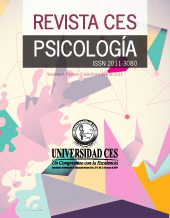New approaches to maximization: evidence of correlations with malaise and well-being in the chilean adult population*
DOI:
https://doi.org/10.21615/cesp.13.1.2Keywords:
Maximization, Maximizing Behavior, Satisficing Behavior, Decision Making, Malaise, Regret, Well-BeingAbstract
There is a lack of theoretical consensus about the decision-making process and particularly regarding the maximization construct. Recently, two conceptual approaches to maximization and their respective instruments were proposed. The first defines maximization as consisting of two dimensions, goal and strategy. The second differentiates between the two types of maximization according to the way an individual makes decisions, one is resolute and the other is fearful. Regarding the first approach, empirical goal and strategy relationships with emotional consequences on well-being and discomfort are unknown while deciding, while it is doubt whether the distinction proposed in the second approach also applies to the adult population and in contexts different from the European one. Empirical associations are evaluated here for each approach regarding indicators of malaise and well-being through a set of hypotheses. A sample of 624 Chilean adults of both sexes (20 to 70 years old) answered eight instruments on maximization, its components and types, and well-being and malaise. The results for both approaches show greater associations with rates of malaise than well-being. The results for the first approach show a more intense association with indices of malaise and well-being for strategy than goal. In the second approach, these associations are stronger and greater for fearful maximization than for resolute. The results contribute by increasing the understanding of the maximization construct by simultaneously showing that the increment in the strategy search for alternatives and the fearful style of maximization are directly associated with difficulty in deciding and regret.
Downloads
References
Abbe, A., Tkach, C., & Lyubomirsky. S. (2003). The art of living by dispositionally happy people. Journal of Happiness Studies, 4, 385-404. doi: http://dx.doi.org/10.1023/B:JOHS.0000005769.54611.3c
Besharat, A., Madik, D., & Carrillat, F. (2014). Are maximizers blind to the future? When today’s best does not make for the better tomorrow. Mak Lett, 25, 77-91. doi: http://dx.doi.org/10.1007/s11002-013-9243-4
Briggs, S. R., & Cheek, J. M. (1986). The role of factor analysis in the development and evaluation of personality scales. Journal of Personality, 54(1), 106–148. doi: https://doi.org/10.1111/j.1467-6494.1986.tb00391.x
Chang, E.C., Lin, N.J., Herringshaw, A.J., Sanna, L.J., Fabian, C.G. Perera, M.J., & Marchenko, V.V. (2011) Understanding the link between perfectionism and adjustment in college students: Examining the role of maximization. Personality and Individual Differences, 50, 1074-1078. doi: http://dx.doi.org/10.1016/j.paid.2011.01.027
Cheek, N., & Schwartz, B. (2016). On the meaning and measurement of maximization. Judgment and Decision Making, 11(2), 126-146. doi: http://journal.sjdm.org/16/16129b/jdm16129b.pdf
Cote Rangel, L.P., & García Barrera, A.M. (2016). Estrés como factor limitante en el proceso de toma de decisiones: una revisión desde las diferencias de género. Avances en Psicología Latinoamericana, 34(1), 19-28. doi: http://dx.doi.org/10.12804/apl34.1.2016.02
Dar-Nimrod, I., Rawn, C. D., Lehman, D. R., & Schwartz, B. (2009). The maximization paradox: The costs of seeking alternatives. Pers. and Individual Differences, 46, 631-635. doi: http://dx.doi.org/10.1016/j.paid.2009.01.007
Dalal, D. K., Diab, D. L., Zhu, X. S., & Hwang, T. (2015). Understanding the construct of maximizing tendency: A theoretical and empirical evaluation. Journal of Behavior and Decision Making, 28, 437-450. doi: https://doi.org/10.1002/bdm.1859
Diab, D.L, Gillespie, M.A., & Highhouse, S. (2008). Are maximizers really unhappy? The measurement of maximizing tendency. Judgment and Decision Making, 3(5) 364-370.
Diener, E., Larson Emmons, R.A., Larsen, R.J., & Griffin, S. (1985). The satisfaction with the life scale. Journal of Personality Assessment, 49, 71-75. doi: https://doi.org/10.1207/s15327752jpa4901_13
Ďuriník, M., Procházka, J., & Cígler, H. (2018). The Short Maximization Inventory. Judgment and Decision Making, 13(1) 123-136.
Fernández Arbeláez, J. I., & Villada Zapata, J. (2015). Analysis of Evidence in Decision-Making Research between 2002 and 2012. Avances en Psicología Latinoamericana, 33(1), 105-120. doi: http://dx.doi.org/10.12804/apl33.01.2015.08
Harman, J. L., Weinhardt, J. M., & González, C. (2018). Maximizing Scales Do Not Reliably Predict Maximizing Behavior in Decisions from Experience. Journal of Behavioral Decision Making, 31(3), 402–414. doi: https://doi.org/10.1002/bdm.2070
Hair, J.F., Anderson, R.E., Tatham, R.L., & Black, W.C. (1999). Análisis Multivariante (5ª Ed.). Madrid: Prentice-Hall.
Han, B.-C. (2017). La sociedad del cansancio (2ª Ed.). España: Herder
Hughes, J., & Scholer, A. A. (2017). When Wanting the Best Goes Right or Wrong: Distinguishing Between Adaptive and Maladaptive Maximization. Personality and Social Psychology Bulletin, 43(4), 570–583. doi: https://doi.org/10.1177/0146167216689065
Iyengar, S., Wells, R., & Schwartz, B. (2006). Doing better but feeling worse: Looking for the best job undermines job satisfaction. Psychological Science, 17, 143-150. doi: http://dx.doi.org/10.1111/j.1467-9280.2006.01677.x
JASP Team. (2017). JASP (Version 0.8.3) [Computer software]. https://jasp-stats.org/
Lipovetsky, G. (2008). La sociedad de la decepción. Entrevista con Bertrand Richard. Barcelona, España: ANAGRAMA.
Luybomirsky, S., & Lepper, H.S. (1999). A measure of subjective happiness: preliminary reliability and construct validation. Social Indicators Research, 46, 137-155. doi: https://doi.org/10.1023/A:1006824100041
Luan, M., & Li, H. (2017). Good enough-compromise between desirability and feasibility: An alternative perspective on satisficing. J. of Experimental Social Psychology, 70, 110-116. doi: http://dx.doi.org/10.1016/j.jesp.2017.01.002
Misuraca, R., Faraci, P., Gangemi, A., Carmeci, F. A., & Miceli, S. (2015). The Decision Making Tendency Inventory: A new measure to assess maximizing, satisficing, and minimizing. Personality and Individual Differences, 85, 111–116. doi: http://dx.doi.org/10.1016/j.paid.2015.04.043
Misuraca, R., & Fasolo, B. (2018). Maximizing versus satisficing in the digital age: Disjoint scales and the case for “construct consensus”. Personality and Individual Differences, 121, 152–160. doi: https://doi.org/10.1016/j.paid.2017.09.031
Moyano-Díaz, E. (2010). Exploración de algunas propiedades psicométricas de las escalas de satisfacción vital, felicidad subjetiva y autopercepción de salud. En Moyano-Díaz, E. (Ed), Calidad de Vida y Psicología en el bicentenario de Chile (pp. 447-470). Santiago, Chile: Gráfika Marmor.
Moyano-Díaz, E., Martínez-Molina, A., & Ponce, P. F. (2014). The price of gaining: maximization in decision-making, regret and life satisfaction. Judgment and Decision Making, 9(5), 500-509.
Moyano-Díaz, E. Cornejo, F., Carreño, M., & Muñoz, A. (2013). Bienestar subjetivo en maximizadores y satisfascedores. Terapia Psicológica, 13(3), 373-380. doi: https://dx.doi.org/10.4067/S0718-48082013000300001
Moyano-Díaz, E., Palomo-Vélez, G., & Mendoza-Llanos, R. (2016). Adaptación preliminar del Maximization Inventory (MI) de Turner et al. (2012) en muestra de estudiantes universitarios chilenos. Documento de trabajo (Working Paper), Grupo de Investigación en Calidad de Vida y Ambientes Saludables, Facultad de Psicología, Universidad de Talca (Chile).
Moyano-Díaz, E., & Ramos, N. (2007). Bienestar Subjetivo: Midiendo satisfacción vital, felicidad y salud en población chilena de la Región del Maule. Universum, 22(2), 184–200. doi: http://dx. doi.org/10.4067/S0718-23762007000200012
Nenkov, G.Y., Morrin, M., Ward, A., Schwartz, B., & Hulland, J. (2008). A short form of the maximization scale: Factor structure, reliability and validity studies. Judgment and Decision Making, 3, 371-388.
Newman, D. B., Schug, J., Yuki, M., Yamada, J., & Nezlek, J. B. (2018). The negative consequences of maximizing in friendship selection. Journal of Personality and Social Psychology, 114(5), 804-824. doi: http://dx.doi.org/10.1037/pspp0000141
Parker, A. M., Bruine de Bruin, W., & Fischoff, B. (2007). Maximizers versus satisficers: Decision Making styles, competence, and outcomes. Judgment and Decision Making, 2, 342-350.
Polman, E. (2010). Why are maximizers less happy than satisficers? Because they maximize positive and negative outcomes. J. of Behav. Dec. Making, 23, 179-190. doi: http://dx.doi.org/10.1002/bdm.647
Purvis, A., Ryan T.H., & Iyer, R. (2011). Exploring the role of personality in the relationship between maximization and well-being. Personality and Individual Differences, 50(3), 370-375. doi: http://dx.doi.org/10.1016/j.paid.2010.10.023
Richardson, C.M.E., Ye, H.J., Ege, E., Süh, H., & Rice, K. G. (2014). Refining the measurement of maximization: Gender invariance and relation to psychological well-being. Personality and Individual Differences, 70, 229-234. doi: http://dx.doi.org/10.1016/j.paid.2014.06.048
Rim, H., Turner, B.M., Betz, N.E., & Nygren, T. E. (2011). Studies of the dimensionality, correlates, and meaning of measures of the maximizing tendency. Judgment and Decision Making 6, 565-579.
Schwartz, B., Ward, A., Monterosso, J., Lyubomirsky, S., White, K., & Lehman, D. (2002). Maximizing versus satisficing. J. of Personality and Social Psychology, 83, 1178-1197. doi: http://dx.doi.org/10.1037/0022-3514.83.5.1178
Schwartz, B. (2004). The paradox of choice: Why more is less. New York: Harper Perennial.
Schermelleh-Engel, K., Moosbrugger, H., & Müller, H. (2003). Evaluating the Fit of Structural Equation Models: Test of Significance and Descriptive Goodness-of-Fit Measures. Methods of Psychological Research Online, 8(2), 23-74.
Simon, H. A. (1955). A behavioral model of rational choice. Quart. J. of Economics, 59, 99-118. doi: http://dx.doi.org/10.2307/1884852
Spark, E.A., Ehrlinger, J., & Eibach, R.P. (2012). Failing to commit: Maximizers avoid commitment in a way that contributes to reduced satisfaction. Personality and Individual Differences, 52, 72-77. doi: http://dx.doi.org/10.1016/j.paid.2011.09.002
Turner, B., Rim, H. B., Betz, N., & Nygren, T. E. (2012). The Maximization Inventory. Judgment and Decision Making, 7, 48-60.
Weinhardt, J.M., Morse, B.J., Chimeli, J., & Fisher, J. (2012). An item response theory and factor analysis examination of two prominent maximizing tendency scales. Judgment and Decision Making, 7, 644-658.
Downloads
Published
How to Cite
Issue
Section
License
Copyright (c) 2019 CES Psicología

This work is licensed under a Creative Commons Attribution-NonCommercial-ShareAlike 4.0 International License.
Each manuscript is accompanied by a statement specifyingThat the materials are unpublished, that have not been previously published in printed formatElectronic and that they will not be presented to any other means before knowing the decision of the magazine. ThroughoutIn case, any previous publication, sea in printed or electronic form, must be made known to the editorial staffWriting The authors attach a signed statement stating that, and the manuscript is acceptedFor publication, the rights of reproduction are the exclusive property of the Journal CES Psychology.


